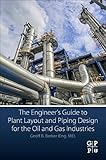The engineer's guide to plant layout and piping design for the oil and gas industries / Geoff Barker.
Material type: TextPublisher: ©2018Description: xxii, 510 pages : illustrations ; 24 cmContent type:
TextPublisher: ©2018Description: xxii, 510 pages : illustrations ; 24 cmContent type: - text
- unmediated
- volume
- 9780128146538
- TH4571 .B37 2018
| Item type | Current library | Call number | Status | Date due | Barcode | |
|---|---|---|---|---|---|---|
| Books - Printed | PERPUSTAKAAN GUNASAMA HAB PENDIDIKAN TINGGI PAGOH Main Library General | TH4571 .B37 2018 (Browse shelf(Opens below)) | Available | 0000005675 | ||
| Books - Printed | PERPUSTAKAAN GUNASAMA HAB PENDIDIKAN TINGGI PAGOH Main Library General | TH4571 .B37 2018 (Browse shelf(Opens below)) | Available | 0000005674 |
Browsing PERPUSTAKAAN GUNASAMA HAB PENDIDIKAN TINGGI PAGOH shelves, Shelving location: Main Library General Close shelf browser (Hides shelf browser)
1. Engineers and Designers -- Career Paths; 2. Piping Materials -- Process Terms and Piping Codes; 3. Fundamentals of Plant Layout Design -- Plot Plans; 4. Piping and Equipment Basis for Selection; 5. Vessels and Drums; 6. Exchangers; 7. Pumps; 8. Compressors; 9. Furnaces; 10. Reactors; 11. Towers; 12. Piperacks and Structures; 13. Underground Piping; 14. Instruments; 15. Storage Tanks; 16. Utility Stations, Steam, and Condensate Piping; 17. Pipe Supports -- Selection, Anchors, Guides, and Restraints; 18. Pipe Sizing and Pressure Drop Calculations; 19. Piping Stress Analysis and Layout of Hot Piping
The Engineer's Guide to Plant Layout and Piping Design for the Oil and Gas Industries gives pipeline engineers and plant managers a critical real-world reference to design, manage, and implement safe and effective plants and piping systems for today's operations. This book fills a training void with complete and practical understanding of the requirements and procedures for producing a safe, economical, operable and maintainable process facility. Easy to understand for the novice, this guide includes critical standards, newer designs, practical checklists and rules of thumb. Due to a lack of structured training in academic and technical institutions, engineers and pipe designers today may understand various computer software programs but lack the fundamental understanding and implementation of how to lay out process plants and run piping correctly in the oil and gas industry. Starting with basic terms, codes and basis for selection, the book focuses on each piece of equipment, such as pumps, towers, underground piping, pipe sizes and supports, then goes on to cover piping stress analysis and the daily needed calculations to use on the job.
There are no comments on this title.






